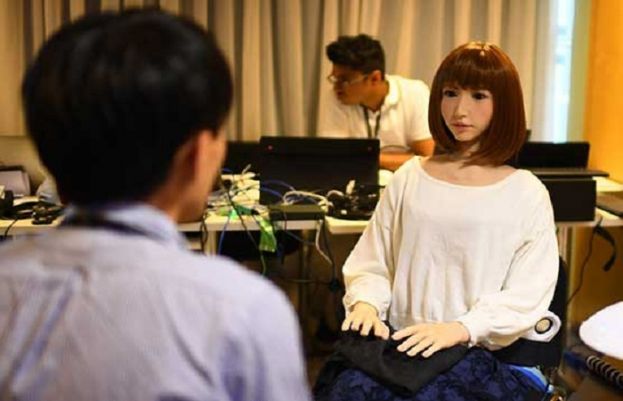
She and others like her are a prime focus of robotic research, as their uncanny human form could be key to integrating such machines into our lives, said researchers gathered this week at the annual International Conference on Intelligent Robots.
"You mentioned project management. Can you please tell me more?" Erica, who is playing the role of an employer, asks the man.
She may not understand the conversation, but she’s been trained to detect key words and respond to them.
A source of controversy due in part to fears for human employment, the presence of robots in our daily lives is nevertheless inevitable, engineers at the conference said.
The trick to making them more palatable, they added, is to make them look and act more human so that we accept them into our lives more easily.
In ageing societies, "robots will coexist with humans sooner or later", said Hiroko Kamide, a Japanese psychologist who specialises in relations between humans and robots.
Welcoming robots into households or workplaces involves developing "multipurpose machines that are capable of interacting" with humans without being dangerous, said Philippe Soueres, head of the robotics department at a laboratory belonging to France’s CNRS scientific institute.
Human, but not too human
As such, robots must move around "in a supple way" despite their rigid mechanics and stop what they are doing in case of any unforeseen event, he added.
That’s why people are choosing "modular systems shaped like human bodies" which are meant to easily fit into real-world environments built for humans.
For instance Atlas, a humanoid robot made by Boston Dynamics, can run on different types of surfaces.
In Madrid, Marc Raibert, founder of the US firm, played a video showing Atlas doing a backflip.
In a sign of fears over the potential future uses for these humanoids, Amnesty International has accused Atlas, financed by an agency of the US Department of Defense, of being a "killer robot" made for future warfare.
Another example of humanoids presented in Madrid is Talos, a robot made by Spanish company Pal Robotics shown testing his stability on a balance board.
While it may not be the only form used for those coming into contact with humans, "it’s easier for people to accept the robots when they have human-like faces because people can expect how the robots will move, will react," said Kamide.
That’s comforting, but it also has its limits.
Japanese researcher Masahiro Mori’s "uncanny valley" theory, which he developed in the 1970s, states that we react positively to robots if they have physical features familiar to us but they disturb us if they start looking too much like us.
"You can’t ever make a perfect human face" and this imperfection provokes a feeling of "rejection" among humans, said Miguel Salichs, a professor at the robotics lab of Madrid’s Carlos III University.
As such, he chose to fashion his robot Mini Maggie into a small cartoon animal.
‘Understand humans’
In Japan, robots like Erica are already used as receptionists.
But for one of their makers, Hiroshi Ishiguro, a professor at Osaka University, humanoids are above all "a very important tool to understand humans".
Researchers have to think hard about the human form and how humans interact to develop robots that look like them.
"We understand the humans by using robots, the importance for example of eye gazing," said Ishiguro, who has also made robots that look like dead celebrities, or "moving statues".
He believes that humanoids are best to improve interactions between robots and humans.
"The human brain that we have has many functions to recognise humans. The natural interface for the humans is the humans," said Ishiguro.
For Jurgen Schmidhuber, president of artificial intelligence start-up NNAISENSE, robots -- be they humanoid or not -- will be part of our future.
They won’t just imitate humans but will solve problems by experimenting themselves thanks to artificial intelligence without "a human teacher," he believes.
Sitting on her chair, Erica nods her head.
from Science & Technology - SUCH TV - SUCH TV https://ift.tt/2pDorXg


No comments:
Post a Comment